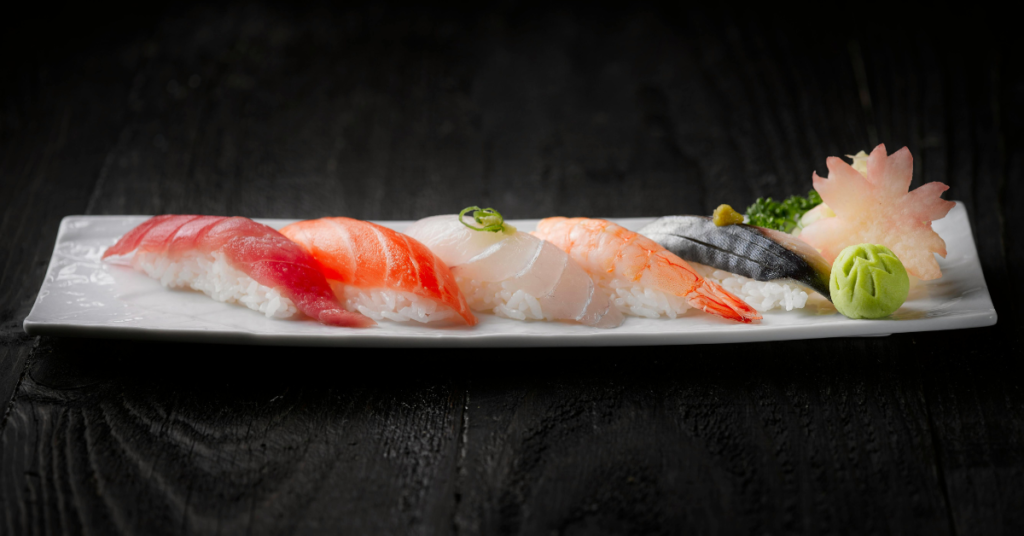Here the Top 4 Fish is a highly nutritious food that plays a vital role in the American diet. Whether it’s grilled salmon, sushi, or a simple fish fillet, this versatile ingredient is rich in essential nutrients, making it a popular choice for health-conscious individuals. In this article, we’ll explore the benefits of eating fish, the different types available, and how to cook fish to maximize flavor and nutrition.

Top 4 Fish For Healthy Life
The Nutritional Powerhouse: Why You Should Eat Fish
Fish is often regarded as a superfood due to its impressive nutritional profile. It is rich in protein, healthy fats, vitamins, and minerals, all of which contribute to overall health and well-being. Here’s a closer look at what makes fish an essential part of a balanced diet:
- Omega-3 Fatty Acids: Fish, especially fatty fish like salmon, mackerel, and sardines, is one of the best sources of omega-3 fatty acids. These essential fats play a crucial role in heart health by reducing inflammation, lowering blood pressure, and improving cholesterol levels. Omega-3s are also beneficial for brain health, supporting cognitive function and reducing the risk of neurodegenerative diseases.
- High-Quality Protein: Fish is an excellent source of high-quality protein, which is essential for building and repairing tissues, supporting immune function, and maintaining muscle mass. Protein from fish is easily digestible and contains all the essential amino acids that the body needs.
- Vitamins and Minerals: Fish is packed with vitamins and minerals, including vitamin D, B vitamins, selenium, and iodine. Vitamin D is vital for bone health and immune function, while B vitamins play a role in energy metabolism and red blood cell formation. Selenium and iodine are important for thyroid function and overall metabolism.
- Low in Saturated Fat: Unlike red meat, fish is low in saturated fat, making it a heart-healthy choice. Consuming fish regularly can help reduce the risk of heart disease and stroke.
Types of Fish: A Guide to Popular Choices
There are countless types of fish available in the market, each with its unique flavor, texture, and nutritional benefits. Here’s a guide to some of the most popular fish consumed in the USA:
1. Salmon: A Nutritional Powerhouse and Culinary Delight
Salmon is one of the most popular and nutritious types of fish consumed worldwide. Known for its rich flavor, versatility in cooking, and exceptional health benefits, salmon is a staple in many diets, particularly in the USA. Here’s an in-depth look at what makes salmon such a prized ingredient.

Nutritional Benefits of Salmon
- Rich in Omega-3 Fatty Acids:
- Salmon is an excellent source of omega-3 fatty acids, particularly EPA (eicosapentaenoic acid) and DHA (docosahexaenoic acid). These essential fats play a crucial role in heart health by reducing inflammation, lowering triglyceride levels, and improving arterial function. Regular consumption of salmon can significantly reduce the risk of heart disease.
- High-Quality Protein:
- Salmon is a great source of high-quality protein, which is essential for muscle growth, tissue repair, and overall body function. A single serving of salmon provides around 22-25 grams of protein, making it an ideal food for those looking to build or maintain muscle mass.
- Packed with Vitamins and Minerals:
- Salmon is loaded with essential vitamins and minerals, including vitamin D, B vitamins (B12, B6, niacin), selenium, and potassium. Vitamin D supports bone health and immune function, while B vitamins are crucial for energy metabolism and brain health. Selenium acts as an antioxidant, protecting cells from damage, and potassium helps regulate blood pressure.
- Antioxidants:
- Wild-caught salmon, in particular, contains astaxanthin, a powerful antioxidant responsible for its pink color. Astaxanthin has been shown to reduce the risk of heart disease by lowering LDL (bad) cholesterol and increasing HDL (good) cholesterol. It also has anti-inflammatory properties and may help protect the skin from UV damage.
- Low in Saturated Fat:
- Unlike red meat, salmon is low in saturated fat, making it a heart-healthy choice. The fat in salmon is mostly unsaturated, contributing to its health benefits rather than detracting from them.
Culinary Uses of Salmon
Salmon’s rich, buttery flavor and firm texture make it incredibly versatile in the kitchen. It can be prepared in numerous ways, catering to various tastes and preferences:
- Grilled Salmon:
- Grilling is a popular method that enhances the natural flavors of salmon. Whether seasoned simply with salt, pepper, and olive oil, or marinated with herbs and spices, grilled salmon is a delicious and healthy option. It pairs well with a variety of sides, such as roasted vegetables, quinoa, or a fresh salad.
- Baked Salmon:
- Baking salmon is a foolproof way to ensure it remains moist and tender. This method allows you to infuse the fish with different flavors, from garlic and lemon to soy sauce and ginger. Baking is also a healthier option, as it requires minimal added fat.
- Smoked Salmon:
- Smoked salmon is a delicacy enjoyed around the world. It’s often served cold, sliced thinly, and paired with bagels, cream cheese, and capers. Smoked salmon can also be used in salads, pasta dishes, or as a topping for crackers and canapés.
- Salmon Sushi and Sashimi:
- In Japanese cuisine, salmon is a favorite for sushi and sashimi. Its firm texture and rich flavor make it perfect for raw preparations. Sushi-grade salmon is typically served with rice, seaweed, and a variety of toppings, while sashimi is enjoyed plain or with a bit of soy sauce and wasabi.
- Poached Salmon:
- Poaching is a gentle cooking method that preserves the delicate flavor and texture of salmon. Poached salmon is often served with a light sauce, such as dill or hollandaise, and is a great option for a healthy, low-fat meal.
- Salmon Burgers:
- For a fun and healthy twist on a classic, salmon burgers are a delicious alternative to beef. Made with fresh or canned salmon, herbs, and breadcrumbs, these burgers are flavorful, nutritious, and perfect for grilling.
- Salmon Salads:
- Flaked or grilled salmon can be added to salads for a protein boost. Whether it’s a simple green salad or a more elaborate mix of grains, vegetables, and dressing, salmon adds richness and depth to any dish.
- Salmon Soups and Chowders:
- Salmon is also a wonderful addition to soups and chowders. Its robust flavor holds up well in creamy broths, making it a comforting and satisfying option during colder months.
Health Considerations and Sustainability
- Wild-Caught vs. Farmed Salmon:
- When choosing salmon, it’s important to consider the difference between wild-caught and farmed options. Wild-caught salmon, such as Alaskan salmon, tends to have a more natural diet, resulting in higher levels of omega-3 fatty acids and fewer contaminants. Farmed salmon, while still nutritious, may contain more pollutants and have a higher fat content due to their diet in captivity.
- Mercury Content:
- Like many fish, salmon can contain trace amounts of mercury. However, salmon is generally considered to have lower mercury levels compared to larger, predatory fish like tuna. Eating salmon in moderation is safe and offers numerous health benefits without the risks associated with high mercury exposure.
- Sustainability:
- Choosing sustainably sourced salmon is crucial for protecting marine ecosystems. Look for certifications such as the Marine Stewardship Council (MSC) or labels indicating that the salmon is sustainably harvested. Supporting sustainable practices ensures that future generations can continue to enjoy this nutritious and delicious fish.
Conclusion
Salmon is not just a delicious addition to your diet; it’s a powerhouse of nutrition that supports overall health. From its rich omega-3 content to its high-quality protein and essential vitamins, salmon offers numerous benefits that make it a standout choice for those looking to eat healthily. Whether you enjoy it grilled, baked, smoked, or raw, salmon is a versatile ingredient that can be incorporated into a wide variety of dishes. By choosing sustainably sourced salmon, you can enjoy this incredible fish while also supporting the health of our oceans.
2. Tuna: A Versatile and Nutrient-Dense Seafood
Tuna is a widely consumed fish known for its firm texture, rich flavor, and impressive nutritional profile. Whether enjoyed fresh, canned, or in various culinary dishes, tuna is a favorite among seafood lovers in the USA and beyond. Here’s an in-depth exploration of what makes tuna such a valuable addition to your diet.

Nutritional Benefits of Tuna
- High-Quality Protein:
- Tuna is an excellent source of lean protein, making it a great choice for those looking to build muscle, maintain a healthy weight, or simply enjoy a satisfying meal. A 3-ounce serving of tuna provides around 20-25 grams of protein, which supports muscle growth, tissue repair, and overall body function.
- Rich in Omega-3 Fatty Acids:
- Like salmon, tuna is rich in omega-3 fatty acids, particularly EPA and DHA. These essential fats are known for their heart-protective benefits, including reducing inflammation, lowering triglyceride levels, and improving heart health. Regular consumption of tuna can help reduce the risk of cardiovascular diseases.
- Packed with Vitamins and Minerals:
- Tuna is loaded with essential vitamins and minerals, including vitamin D, B vitamins (B12, niacin, B6), selenium, and iodine. Vitamin D supports bone health and immune function, while B vitamins are crucial for energy metabolism and brain health. Selenium acts as an antioxidant, and iodine is essential for thyroid function.
- Low in Calories and Fat:
- Tuna is naturally low in calories and fat, particularly when compared to red meat. This makes it an ideal choice for those seeking a low-calorie, nutrient-dense food option. Canned tuna in water is especially low in fat, while canned tuna in oil provides a richer flavor with slightly higher fat content.
- Antioxidants:
- Tuna contains antioxidants like selenium, which help protect the body from oxidative stress and may reduce the risk of chronic diseases, including cancer. Selenium also supports thyroid function and immune health.
Culinary Uses of Tuna
Tuna’s versatility in the kitchen makes it a favorite ingredient for a wide range of dishes. Whether you’re cooking with fresh tuna steaks or using canned tuna, there are countless ways to enjoy this delicious fish:
- Grilled Tuna Steaks:
- Grilled tuna steaks are a popular way to enjoy this fish. With their firm texture and mild flavor, tuna steaks can be seasoned with simple herbs, spices, or marinades, then grilled to perfection. Tuna steaks pair well with a variety of sides, such as steamed vegetables, rice, or a fresh salad.
- Tuna Sushi and Sashimi:
- In Japanese cuisine, tuna is a staple for sushi and sashimi. Known as “maguro” or “ahi,” raw tuna is prized for its smooth texture and rich flavor. Sushi-grade tuna is often served with rice, seaweed, and various toppings, while sashimi is enjoyed plain or with soy sauce and wasabi.
- Tuna Salad:
- Tuna salad is a classic dish that can be made with canned tuna, mayonnaise, celery, onions, and other ingredients. It’s a versatile dish that can be served on bread as a sandwich, on crackers as a snack, or over greens as a light meal.
- Tuna Pasta:
- Tuna pasta is a comforting and easy-to-make dish. Canned tuna is often combined with ingredients like tomatoes, garlic, olive oil, and herbs to create a flavorful sauce that pairs well with pasta. Tuna pasta can be made in various styles, from creamy tuna alfredo to light and zesty Mediterranean versions.
- Tuna Casserole:
- Tuna casserole is a popular comfort food, particularly in American households. This dish typically includes canned tuna, pasta, and a creamy sauce, often topped with breadcrumbs or cheese. It’s a hearty, filling meal that’s easy to prepare and great for feeding a crowd.
- Seared Tuna:
- Seared tuna, often prepared with ahi tuna, is a delicacy enjoyed by seafood enthusiasts. The tuna is typically seared quickly on high heat, leaving the center rare and tender. It’s often served with a drizzle of soy sauce, a squeeze of lemon, or a light dipping sauce.
- Tuna Poke:
- Poke, a Hawaiian dish, features raw tuna cut into cubes and marinated with soy sauce, sesame oil, and other seasonings. It’s usually served over rice with toppings like avocado, seaweed, and pickled vegetables. Tuna poke is a fresh, healthy option that’s perfect for warm weather.
- Tuna Sandwiches and Wraps:
- Tuna sandwiches are a quick and easy meal option. Made with canned tuna, lettuce, tomato, and condiments, these sandwiches are perfect for lunch or a light dinner. Tuna wraps are a modern twist, often including additional ingredients like avocado, cucumbers, and sprouts.
Health Considerations
- Mercury Content:
- One of the primary concerns with tuna consumption is its mercury content. Larger species of tuna, such as albacore and bluefin, tend to have higher levels of mercury due to their position higher up the food chain. To minimize mercury exposure, it’s recommended to limit intake to a few servings per week, especially for pregnant women, young children, and those with health concerns.
- Sustainability:
- Overfishing and bycatch are significant issues in the tuna industry. Choosing sustainably sourced tuna, such as those certified by the Marine Stewardship Council (MSC), can help support environmentally responsible fishing practices. Additionally, opting for tuna species with lower mercury levels, like skipjack or yellowfin, can be a more sustainable and health-conscious choice.
- Canned vs. Fresh Tuna:
- Canned tuna is a convenient and affordable option, but it’s essential to be mindful of sodium content, especially in varieties packed in brine or oil. Fresh tuna, on the other hand, offers a more luxurious experience but comes at a higher cost. Both forms have their advantages, depending on your dietary needs and preferences.
Conclusion
Tuna is a versatile, nutritious, and delicious seafood that offers numerous health benefits. Its high protein content, rich omega-3 fatty acids, and essential vitamins and minerals make it an excellent choice for those looking to maintain a healthy diet. Whether enjoyed fresh or canned, tuna can be incorporated into a wide variety of dishes, from salads and sandwiches to sushi and casseroles. By choosing sustainably sourced tuna and being mindful of mercury content, you can enjoy this wonderful fish while supporting your health and the environment.
3. Cod: A Nutritious and Versatile Seafood
Cod is a widely enjoyed fish known for its mild flavor, flaky texture, and impressive nutritional benefits. Popular in various cuisines, cod is a staple in many American households and seafood dishes. Here’s an in-depth look at what makes cod such a valuable and versatile ingredient in the kitchen.

Nutritional Benefits of Cod
- High-Quality Protein:
- Cod is an excellent source of lean protein, essential for muscle growth, repair, and overall body function. A 3-ounce serving of cooked cod provides approximately 20 grams of protein, making it a great option for those looking to maintain or build muscle mass.
- Low in Calories and Fat:
- Cod is a low-calorie, low-fat fish, which makes it a great choice for weight management and heart health. A 3-ounce serving of cod typically contains about 90-100 calories and less than 1 gram of fat, making it an ideal option for those on a low-fat or calorie-controlled diet.
- Rich in Vitamins and Minerals:
- Cod is packed with essential vitamins and minerals, including vitamin B12, vitamin B6, niacin, phosphorus, and selenium. Vitamin B12 is crucial for nerve function and red blood cell formation, while vitamin B6 supports brain health and metabolism. Phosphorus is important for bone health, and selenium acts as an antioxidant, protecting cells from damage.
- Good Source of Omega-3 Fatty Acids:
- While not as high in omega-3 fatty acids as fatty fish like salmon, cod still provides a beneficial amount of these essential fats. Omega-3s help reduce inflammation, support heart health, and contribute to overall well-being.
- Beneficial for Heart Health:
- Due to its low fat content and omega-3 fatty acids, cod is a heart-healthy option. Regular consumption of cod can help lower cholesterol levels, reduce blood pressure, and improve cardiovascular health.
- Supports Cognitive Function:
- The vitamins and minerals found in cod, particularly vitamin B12 and omega-3 fatty acids, are beneficial for cognitive function. They support brain health, memory, and overall mental clarity.
Culinary Uses of Cod
Cod’s mild flavor and versatile texture make it suitable for a wide variety of dishes. It can be prepared in numerous ways to suit different tastes and preferences:
- Baked Cod:
- Baking is a simple and healthy way to prepare cod. Seasoned with herbs, spices, and a touch of olive oil, baked cod can be served with a variety of sides, such as steamed vegetables, quinoa, or a fresh salad. This method preserves the delicate flavor and flaky texture of the fish.
- Pan-Seared Cod:
- Pan-searing cod creates a deliciously crispy exterior while keeping the interior tender and moist. This cooking method is quick and easy, requiring just a hot skillet and a few minutes per side. Pan-seared cod can be paired with a light sauce, such as lemon butter or a balsamic glaze.
- Cod Fish and Chips:
- A classic British dish, fish and chips feature battered and fried cod served with crispy fries. This iconic meal is enjoyed worldwide and can be made at home with a homemade batter and a side of tartar sauce. For a healthier version, consider baking or air-frying the cod.
- Cod Chowder:
- Cod chowder is a comforting and hearty soup that combines cod with potatoes, onions, celery, and cream. This creamy, flavorful dish is perfect for cold weather and can be customized with additional vegetables or herbs.
- Cod Tacos:
- Cod tacos are a fun and flavorful option for a casual meal. The cod is typically seasoned and cooked, then served in soft tortillas with fresh toppings such as cabbage slaw, avocado, and a tangy salsa or crema.
- Cod En Papillote:
- Cooking cod en papillote involves wrapping the fish in parchment paper with vegetables, herbs, and a splash of wine or broth. This method steams the cod, preserving its moisture and infusing it with the flavors of the accompanying ingredients.
- Cod Cakes:
- Cod cakes are a versatile dish made by combining flaked cod with mashed potatoes, breadcrumbs, and seasonings. The mixture is shaped into cakes and pan-fried until golden and crispy. Cod cakes can be served as an appetizer, side dish, or main course.
- Cod Stir-Fry:
- Cod can be added to stir-fry dishes for a quick and healthy meal. The fish is cooked with vegetables, soy sauce, and other seasonings, making for a flavorful and satisfying dish that pairs well with rice or noodles.
Health Considerations
- Sustainability:
- When choosing cod, it’s important to consider sustainability. Overfishing has been a concern for cod populations, particularly in the North Atlantic. Look for cod that is certified by organizations like the Marine Stewardship Council (MSC) to ensure it is sourced from sustainable fisheries.
- Mercury Content:
- Cod is generally considered to have low mercury levels compared to larger predatory fish. However, it’s still advisable to consume fish in moderation, especially for pregnant women and young children, to minimize potential mercury exposure.
- Allergies:
- While fish allergies are less common than other food allergies, they can occur. If you have a fish allergy or are preparing food for someone with one, be sure to avoid cod and any other fish products.
- Preparation Methods:
- The health benefits of cod can be diminished by unhealthy cooking methods. Opt for baking, grilling, or steaming rather than frying to maintain the nutritional integrity of the fish.
Conclusion
Cod is a nutritious, versatile, and delicious seafood that offers numerous health benefits. With its high-quality protein, low-calorie content, and essential vitamins and minerals, cod is a valuable addition to a balanced diet. Its mild flavor and flaky texture make it suitable for a variety of culinary applications, from classic fish and chips to elegant baked dishes. By choosing sustainably sourced cod and considering health-conscious preparation methods, you can enjoy this fantastic fish while supporting your well-being and the health of our oceans.
4. Tilapia: A Popular and Nutritious Freshwater Fish
Tilapia is a widely consumed fish known for its mild flavor, versatility, and affordability. It’s a popular choice in many households and restaurants due to its pleasant taste and ease of preparation. Here’s an in-depth look at what makes tilapia a valuable and nutritious addition to your diet.

Nutritional Benefits of Tilapia
- High-Quality Protein:
- Tilapia is a great source of lean protein, essential for muscle growth, repair, and overall body function. A 3-ounce serving of cooked tilapia provides approximately 21 grams of protein, making it an excellent choice for those seeking a high-protein, low-fat diet.
- Low in Calories and Fat:
- Tilapia is low in calories and fat, which makes it a favorable option for weight management and heart health. A 3-ounce serving typically contains about 110 calories and 2.5 grams of fat, with a minimal amount of saturated fat.
- Rich in Vitamins and Minerals:
- Tilapia provides essential vitamins and minerals, including vitamin B12, vitamin B6, niacin, phosphorus, and selenium. Vitamin B12 supports nerve function and red blood cell formation, while vitamin B6 aids in brain health and metabolism. Phosphorus is important for bone health, and selenium acts as an antioxidant, protecting cells from damage.
- Omega-3 Fatty Acids:
- Although tilapia is not as high in omega-3 fatty acids as fatty fish like salmon or mackerel, it still provides some beneficial fats. Omega-3s support heart health, reduce inflammation, and contribute to overall well-being. For higher omega-3 content, tilapia can be complemented with other fatty fish in your diet.
- Beneficial for Weight Management:
- Due to its low calorie and fat content, tilapia is an excellent choice for those looking to manage or lose weight. It provides a high protein content that can help you feel full and satisfied while keeping calorie intake in check.
Culinary Uses of Tilapia
Tilapia’s mild flavor and firm texture make it incredibly versatile in the kitchen. It can be prepared in numerous ways to suit different tastes and dietary preferences:
- Grilled Tilapia:
- Grilling tilapia is a simple and healthy way to prepare it. The fish can be seasoned with herbs, spices, or marinades and cooked on a grill or grill pan. Grilled tilapia pairs well with a variety of sides, such as steamed vegetables, rice, or a fresh salad.
- Baked Tilapia:
- Baking tilapia is an easy method that helps retain the moisture and delicate flavor of the fish. The tilapia can be seasoned with lemon, garlic, and herbs, then baked until flaky. This method is ideal for a low-fat, nutritious meal.
- Pan-Seared Tilapia:
- Pan-searing tilapia creates a slightly crispy exterior while keeping the interior tender. This method involves cooking the fish in a hot skillet with a small amount of oil, and it can be enhanced with a squeeze of lemon or a drizzle of sauce.
- Tilapia Fish Tacos:
- Tilapia fish tacos are a fun and flavorful meal option. The fish is typically seasoned and cooked, then served in soft tortillas with fresh toppings such as cabbage slaw, avocado, and salsa. Tilapia fish tacos are perfect for casual gatherings or weeknight dinners.
- Tilapia Stir-Fry:
- Tilapia can be added to stir-fry dishes for a quick and nutritious meal. The fish is cooked with a variety of vegetables, sauces, and seasonings, making it a versatile option that pairs well with rice or noodles.
- Tilapia Fish Cakes:
- Tilapia fish cakes are a delicious way to use leftover fish. Flaked tilapia is mixed with ingredients such as mashed potatoes, breadcrumbs, and seasonings, then formed into cakes and pan-fried until golden and crispy. Fish cakes can be served as an appetizer, side dish, or main course.
- Tilapia Chowder:
- Tilapia chowder is a comforting and hearty soup that combines tilapia with potatoes, onions, celery, and a creamy base. This dish is ideal for cooler weather and can be customized with additional vegetables or herbs.
- Tilapia Ceviche:
- Tilapia ceviche is a refreshing and light dish made by marinating raw tilapia in citrus juices, such as lime or lemon, along with onions, cilantro, and tomatoes. The acidity from the citrus “cooks” the fish, creating a flavorful and vibrant dish.
Health Considerations
- Sustainability:
- Tilapia farming is widespread, and the sustainability of tilapia can vary depending on farming practices. Opt for tilapia that is certified by organizations such as the Aquaculture Stewardship Council (ASC) or the Global Aquaculture Alliance (GAA) to ensure it comes from responsible and environmentally friendly farms.
- Nutrient Profile:
- While tilapia is nutritious, it has a lower omega-3 fatty acid content compared to fatty fish like salmon. To balance your diet, consider incorporating other sources of omega-3s, such as flaxseeds, chia seeds, or other fatty fish.
- Contaminants:
- Like many fish, tilapia may contain trace amounts of contaminants, including pesticides or antibiotics, depending on farming practices. Choosing tilapia from reputable sources and sustainable farms can help minimize these risks.
- Allergies:
- Fish allergies can occur, and tilapia is no exception. If you have a fish allergy or are preparing food for someone with one, ensure to avoid tilapia and other fish products.
Conclusion
Tilapia is a versatile, nutritious, and affordable fish that offers numerous health benefits. With its high-quality protein, low-calorie content, and essential vitamins and minerals, tilapia is a valuable addition to a balanced diet. Its mild flavor and firm texture make it suitable for a wide variety of dishes, from grilled and baked preparations to tacos and chowders. By choosing sustainably sourced tilapia and considering health-conscious preparation methods, you can enjoy this excellent fish while supporting both your well-being and environmentally responsible practices.
Read More : Top 5 Berries: A Nutritional Powerhouse and Delicious Snack
Post Views: 34
Author: Ritesh Gupta
Professional JournalisT











